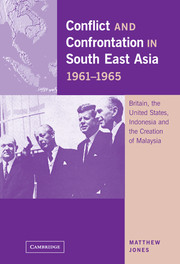 Conflict and Confrontation in South East Asia, 1961–1965
Conflict and Confrontation in South East Asia, 1961–1965 Book contents
- Frontmatter
- Contents
- List of maps
- Preface and acknowledgements
- List of abbreviations
- South East Asia
- Indonesia and Malaysia
- Introduction: Britain, the United States and the South East Asian setting
- Part I Build-up
- 1 The Kennedy Administration, Indonesia and the resolution of the West Irian crisis, 1961–1962
- 2 The Greater Malaysia scheme I: the move towards merger
- 3 The Greater Malaysia scheme II: the Cobbold Commission and the Borneo territories
- 4 Britain, Indonesia and Malaya: from West Irian to the Brunei revolt
- Part II Outbreak
- Part III Denouement
- Conclusion: The Western presence in South East Asia by the 1960s
- Bibliography
- Index
1 - The Kennedy Administration, Indonesia and the resolution of the West Irian crisis, 1961–1962
Published online by Cambridge University Press: 25 July 2009
- Frontmatter
- Contents
- List of maps
- Preface and acknowledgements
- List of abbreviations
- South East Asia
- Indonesia and Malaysia
- Introduction: Britain, the United States and the South East Asian setting
- Part I Build-up
- 1 The Kennedy Administration, Indonesia and the resolution of the West Irian crisis, 1961–1962
- 2 The Greater Malaysia scheme I: the move towards merger
- 3 The Greater Malaysia scheme II: the Cobbold Commission and the Borneo territories
- 4 Britain, Indonesia and Malaya: from West Irian to the Brunei revolt
- Part II Outbreak
- Part III Denouement
- Conclusion: The Western presence in South East Asia by the 1960s
- Bibliography
- Index
Summary
Improving the state of relations with Jakarta occupied an important place in the foreign policy agenda of the Kennedy Administration. Indonesia's size, possession of natural resources, including oil, rubber and tin, strategic location astride lines of communication in the south west Pacific, and the fact that it was home to a significant level of US commercial investment, meant that in the late 1950s and early 1960s the state was often seen as a key prize in the Cold War competition for influence in the non-aligned world. The evident interest that the Soviet Union, under Khrushchev's energetic new leadership, exhibited during this period in cultivating ties with Jakarta, necessarily seemed to enhance Indonesia's importance to American eyes. Sukarno's visit to Moscow in September 1956 was accompanied by the extension of a $100 million long-term credit, while in early 1958 an arms deal totalling $250 million was negotiated, with Poland and Czechoslovakia acting as Soviet intermediaries. President K. I. Voroshilov's state visit to Jakarta in May 1957 had been followed up, even more significantly, by a ten-day tour of Indonesia by Khrushchev in February 1960. When put alongside other initiatives in Russian policy during this period, many American observers came to the conclusion that a Soviet economic offensive was under way in the Third World, with Indonesia one of the prime targets.
Trends within Indonesia's own complex polity did little to reassure the Americans that external Communist influence would not find a welcome audience.
- Type
- Chapter
- Information
- Conflict and Confrontation in South East Asia, 1961–1965Britain, the United States, Indonesia and the Creation of Malaysia, pp. 31 - 60Publisher: Cambridge University PressPrint publication year: 2001


